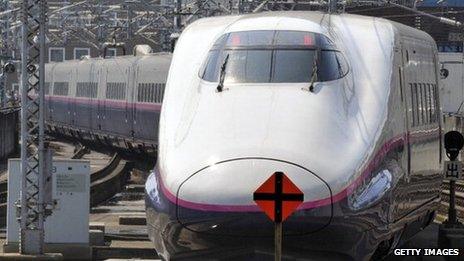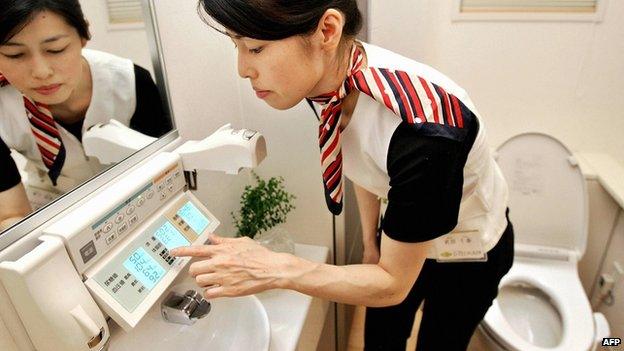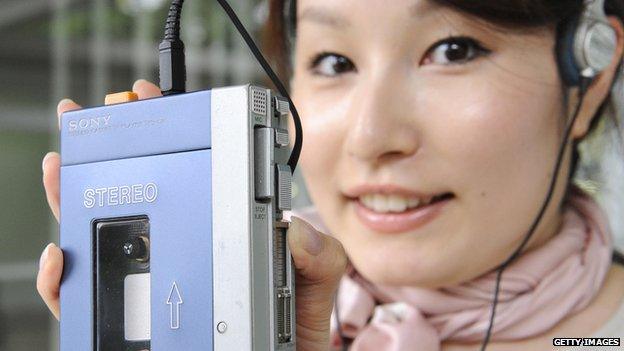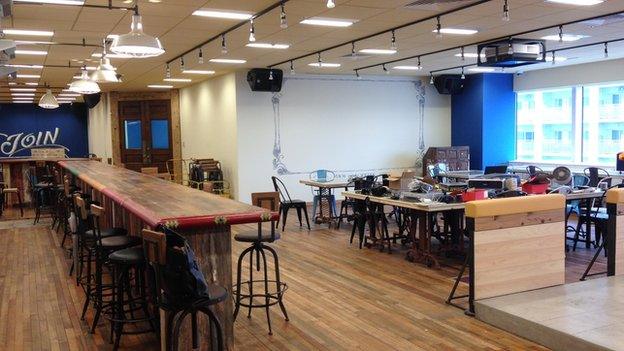Rebooting innovation in Japan
- Published
Mariko Oi reports on Japan's quest to rediscover the Walkman ethos
Guarded by heavy metal gates, it feels like a secret base in the heart of Tokyo. Inside a typical office building in the Akihabara district is a high-tech factory that is created for use by anyone with innovative ideas.
It is a makerspace with equipment worth 1bn yen ($8.5m; £5.5m). Whatever you need to turn your idea into a product is here, including the latest 3D printer.
DMM.make Akiba occupies three floors of the building with total space of 2,000 sq m (21,500 sq ft). It is open 24/7 to members who pay a monthly fee of 30,000 yen.
"I don't know how any of the machines work and we are losing money for now," laughs Keishi Kameyama, chairman of internet company DMM.com, which is behind the investment.
"But I wanted to provide this space to young engineers so that they can focus on creating products that they want," he adds.
To the uninitiated, a makerspace is a physical housing area (it could be a library or a community centre, for instance) that provides technology, manufacturing equipment and/or educational opportunities to the public.

Famous Japanese inventions

Bullet train (1964)
Instant noodles (1958)
Karaoke machine (1971)
Walkman (1979)
PlayStation console (1994)

Dwindling ideas?
Japan is a country known for its innovations.
My favourite has always been the Toto electric toilet seat with water spray feature, which I was surprised to find even at a temporary shelter in Kesennuma in Miyagi, not long after the region was struck by the huge earthquake and tsunami in 2011.
But when I started to look into what happened to Japan's once famous innovative minds, I really struggled.

Japan has long pioneered high-tech toilets. This one allows users to check blood pressure, urine protein, weight and body fat on the control panel
After all Sony's Walkman, which revolutionised how people listened to music, was introduced back in 1979. The bullet train entered service in 1964, which was around the same time that Toto introduced its first high-tech toilet.
Since then, though, "game-changing" products have been difficult to come by. So is Japan's innovation dead?
"We have been innovating great products but we are not good at marketing them abroad," says Mr Kameyama.
Targeting customers
I grew up in Tokyo using NTT DoCoMo's mobile phones, which allowed me to send emails on the go years before the Blackberry smartphone or Apple's iPhone was released.
And yet, when I moved to Singapore to join the BBC, it took me two years to find out that the exact service that I was familiar with back home - called imode - was also available in Singapore.
I remember thinking, "If you cannot market the product to someone who knows about it, how are you supposed to woo users abroad who aren't?"
The problem still exists today.
When I approached a company that offered an innovative idea to Sony (so that engineers from the electronics giant can turn it into an actual product), my request was declined because they were too busy.
The company told me that, from their point of view, "there was no point in being featured by the BBC" because their target customers are in Japan, not abroad.
'Serial innovation'
But marketing strategies aside, can Japan still come up with the next Walkman, or the next big thing, that will woo customers worldwide, in the way Apple and Samsung have done with their arsenal of mobile phones, tablets and even phablets?

Sony's Walkman cassette player revolutionised how people listened to music
"Any organisations have abilities to produce something innovative," says Takuma Iwasa, founder of start-up consumer electronics firm Cerevo, which is one of the main tenants of the makerspace in Akihabara.
"But it's the matter of whether the company's management would allow you to create it and release it to society.
"Sony came up with Walkman when the company was much smaller. Exactly the same with Toto and its high-tech toilets. I don't think it's only in Japan but the bigger the companies get, the harder it becomes to take a risk," says Mr Iwasa, who used to work for Panasonic.
"Big companies, Japanese or not, are good at what I call serial innovation - making a better version of the current product - because that will sell. But they are not good at creating something that never existed in the market."
Government support?
The makerspace in Akihabara, he says, is full of start-up companies that are now at the phase Sony was at when it invented the Walkman and there are investors who are keen to fund their dreams.
So can the government help? The third arrow of Abenomics, the economic policy of Prime Minister Shinzo Abe, is to encourage more innovation.
"It may be a very Japanese thing but when I started Cerevo, there wasn't much support for start-up companies," says Mr Iwasa. "Just the fact that they are promoting entrepreneurship has been helpful."

The privately funded DMM.make Akiba makerspace in Akihabara district houses potential inventors
But DMM.com's Mr Kameyama thinks that the government is only investing in the old system.
"I am not a creator myself so I get it but the government doesn't know how to encourage innovation," he says.
"So they're talking to big electronics companies and giving them money.
"But I want the government to help young inventors who are gathering here because they are the future of Japan's innovation."
- Published3 March 2015
- Published28 January 2015
.jpg)
- Published10 February 2015
- Published21 August 2014

- Published5 September 2014
